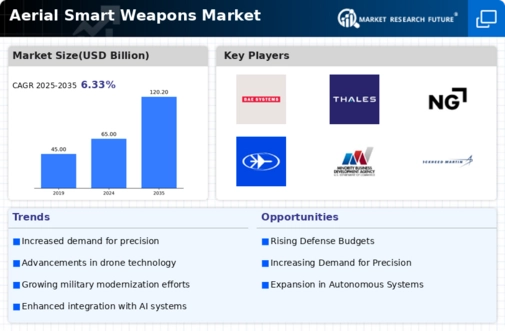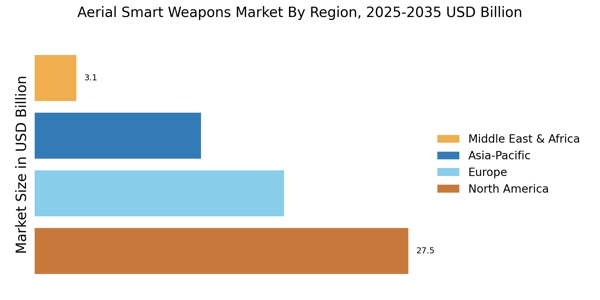North America : Defense Innovation Leader
North America is the largest market for aerial smart weapons, accounting for approximately 45% of the global share. The region's growth is driven by significant defense budgets, technological advancements, and increasing geopolitical tensions. Regulatory support from government agencies, such as the Department of Defense, further catalyzes market expansion, fostering innovation and collaboration among defense contractors.
The United States leads the market, with key players like Lockheed Martin, Northrop Grumman, and Raytheon Technologies dominating the landscape. These companies are at the forefront of developing advanced aerial smart weapon systems, leveraging cutting-edge technologies. Canada also plays a vital role, contributing to the market with its defense initiatives and partnerships with U.S. firms, enhancing regional capabilities.
Europe : Emerging Defense Market
Europe is witnessing a significant rise in the aerial smart weapons market, holding approximately 30% of the global share. This growth is fueled by increasing defense spending among NATO countries, collaborative defense projects, and a focus on enhancing military capabilities. Regulatory frameworks, such as the European Defense Fund, are pivotal in promoting innovation and supporting joint ventures among member states, driving market expansion.
Leading countries in this region include the United Kingdom, France, and Germany, with key players like BAE Systems, Thales Group, and Leonardo S.p.A. These companies are actively involved in developing next-generation aerial smart weapons, focusing on precision and efficiency. The competitive landscape is characterized by strategic partnerships and collaborations aimed at enhancing technological advancements and meeting the evolving defense needs of European nations.
Asia-Pacific : Rapidly Growing Defense Sector
Asia-Pacific is emerging as a significant player in the aerial smart weapons market, accounting for approximately 20% of the global share. The region's growth is driven by rising military expenditures, territorial disputes, and the modernization of armed forces. Countries like India and Japan are increasing their defense budgets, supported by government initiatives aimed at enhancing indigenous defense capabilities and technological advancements.
China and India are the leading countries in this market, with a focus on developing advanced aerial smart weapon systems. The competitive landscape features both state-owned enterprises and private firms, fostering innovation and collaboration. Key players, including Israel Aerospace Industries, are also expanding their presence in the region, contributing to the overall growth and technological advancements in aerial smart weaponry.
Middle East and Africa : Strategic Defense Investments
The Middle East and Africa region is witnessing a growing demand for aerial smart weapons, holding approximately 5% of the global market share. This growth is driven by ongoing conflicts, regional instability, and the need for advanced military capabilities. Countries in the Gulf Cooperation Council (GCC) are significantly increasing their defense budgets, supported by government initiatives aimed at modernizing their armed forces and enhancing security measures.
Leading countries in this region include Saudi Arabia, the UAE, and South Africa, with a focus on acquiring advanced aerial smart weapon systems. The competitive landscape is characterized by partnerships between local firms and international defense contractors, enhancing technological capabilities. Key players like Thales Group are actively involved in providing innovative solutions tailored to the specific needs of the region, contributing to the overall market growth.


















Leave a Comment